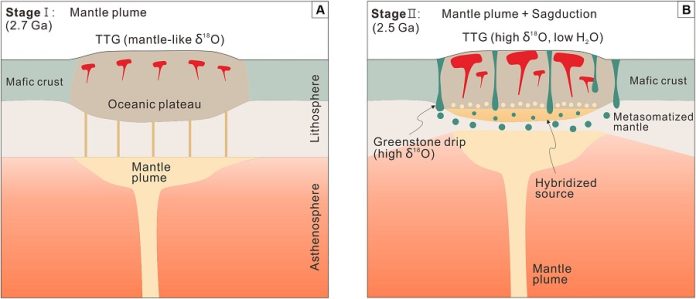
Scientists have long wondered how Earth’s continents first formed.
Now, a team of geologists from the University of Hong Kong (HKU) has made an exciting discovery: early continents may have formed from deep Earth activity called mantle plumes—not from the movement and collision of tectonic plates, as once thought.
More than 2.5 billion years ago, during a time known as the Archean Eon, the Earth looked very different.
Back then, the processes shaping the planet’s surface were not the same as the plate tectonics we see today.
The HKU research team, led by Dr. Dingyi Zhao and Dr. Xiangsong Wang in collaboration with international scientists, found strong evidence that massive upwellings of hot rock from deep inside the Earth—called mantle plumes—were key to forming early continental crust.
The Earth is special because it has continents made of granitoid rocks that support life. But how those continents first formed has been a mystery.
Some scientists believed they formed through plate tectonics, where slabs of the Earth’s crust slide and collide. Others suspected different, deeper processes were at work. This new study supports the second idea.
The researchers studied ancient rocks called TTGs (short for tonalite–trondhjemite–granodiorite) found in northern China.
These rocks are some of the oldest pieces of continental crust, dating back 2.5 billion years. By analyzing tiny crystals called zircons inside these rocks, the scientists could learn about the conditions when the rocks were formed.
They found that the zircons had low water content and oxygen patterns that didn’t match rocks formed in plate collision zones.
Instead, the chemical clues pointed to high temperatures and dry conditions, typical of rocks formed above mantle plumes. These hot plumes would rise from deep within the Earth, causing volcanic rocks to build up on the ocean floor. Later, the intense heat from another plume would partially melt the lower layers of these rocks, creating lighter TTG rocks that eventually became the foundations of continents.
The researchers also discovered signs of a process called sagduction, where surface rocks slowly sink under their own weight into the hotter layers below—another sign of plume activity rather than plate tectonics.
This two-step model—first building up volcanic rocks from a mantle plume, then melting them to create TTGs—offers a fresh explanation for how continents began to form.
The study also shows how using new methods, like measuring water and oxygen in zircon crystals, can help scientists uncover the ancient secrets of our planet. These findings bring us one step closer to understanding how Earth became the home of continents—and of life.



